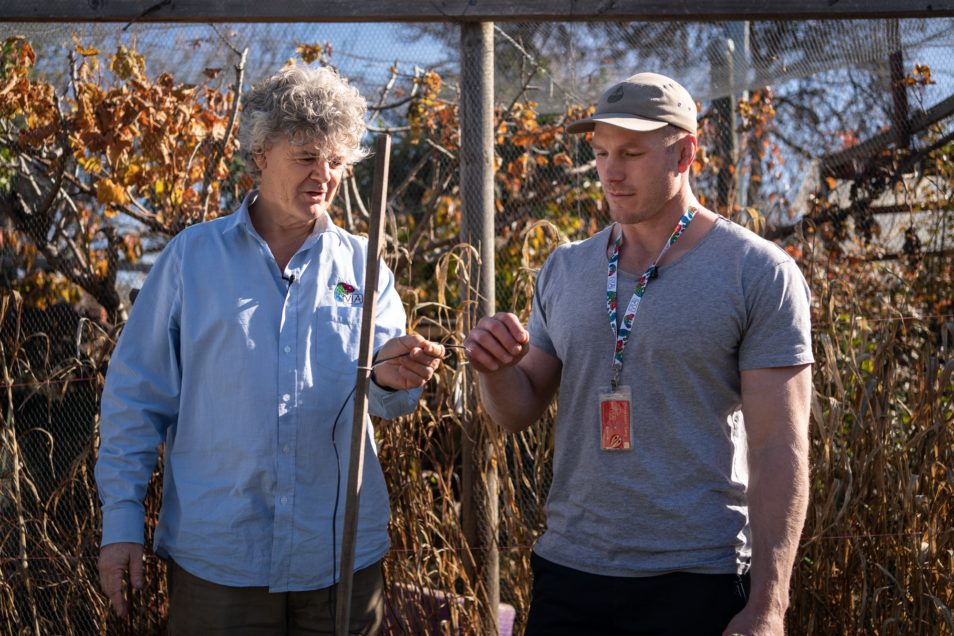
The Chameleon Card – a plant’s best friend.
How does saving water and a booming veggie patch sound? It’s difficult to know how often to give growing veggies a drink and how much to give at one time. Many crops get too much water at the early stages and then too little when they are big. This results in poor yields.
We have developed new technology – now available via the Virtual Irrigation Academy – that makes it possible for backyard green thumbs and the world’s most disadvantaged farmers alike to give their plants the right amount of water.
It’s called the Chameleon soil water sensor. It’s an electronic device that provides gardeners and farmers with information to simultaneously save water and boost their crop yields.
Chameleon Card colours the path to crop success
Our researcher Dr Richard Stirzaker originally developed the Chameleon in 2016. It was created to assist farmers in developing countries to conserve water and improve food security.
“Millions of people irrigate to grow food but do not have simple and accurate information to guide them. The Chameleon uses coloured lights to tell you when to irrigate,” Richard said.
“It’s something that everyone can understand. Farmers using Chameleon sensors quickly changed their practices, many using less water to achieve higher yields.”
Since then many thousands of Chameleon sensors have gone into the ground helping farmers in over 15 countries.
Buried soil moisture sensors connect to a Chameleon card and detect soil moisture levels. The card then displays the data on an incredibly easy to understand readout in the form of one of three colours:
- a green light means there is just enough water in the soil: you will need to water in the next day or so to ensure soil moisture levels remain just right
- a red light means there is too little soil moisture: your crop needs water
- a blue light means there is enough soil moisture: don’t water the crop!
So, what can it achieve? Well, farmers using the Chameleon in countries like Tanzania and Malawi have reported increases to their crop yields of over 50 per cent, while using up to 33 per cent less water.
More food, using less water? Yes please!

Dr Richard Stirzaker (left) demonstrating the Chameleon Card to former Wallaby’s player David Pocock.
A chameleon changes more than its colours
Over time, the Chameleon has been refined. The latest version (called the Chameleon Card) is the size of a credit card.
The good news is the technology is now available to purchase in Australia for home gardeners and farmers.
People who purchase the Chameleon Card are joining a global community who are learning to grow more food with less water and helping to further our research.
If you’ve got an itch for gardening or a loved one who can’t keep a plant alive to save themselves, the Chameleon Card might just be the ticket to a healthier garden. So, how about a Chameleon Christmas Card?


16th December 2020 at 11:31 pm
Whats the difference between Chameleon tech and a $15 soil moisture meter from Bunnings ?
16th December 2020 at 5:46 pm
Looks like a great product but there is insufficient information on how it works and what I need to buy to start with. I run a small vineyard Cabsav 20 acres. What products do I need . Please advise . I will buy immediately.
16th December 2020 at 4:21 pm
Fantastic peeps! I love it, & I know many retired pensioners that love plants but often kill em with love. This would be great!
16th December 2020 at 4:17 pm
Yes the video should have shown how the whole system is set up.
25th December 2020 at 7:48 am
Agree, especially on established gardens. Do you have to dig holes ? Just looks like a fancy version of the portable 3 way meter you buy on E Bay.
16th December 2020 at 12:47 pm
poorly done video, I know as much about product now than when I first looked at the link. Where does the wire come from? Is it special?
16th December 2020 at 3:58 pm
Hi Max, the wires are connected to the soil water sensors that the card uses to display the reading.
Thanks,
Team CSIRO